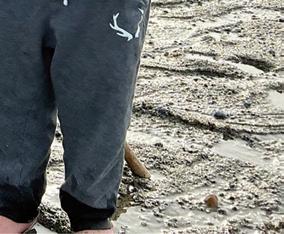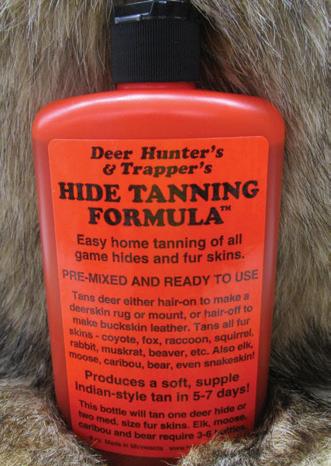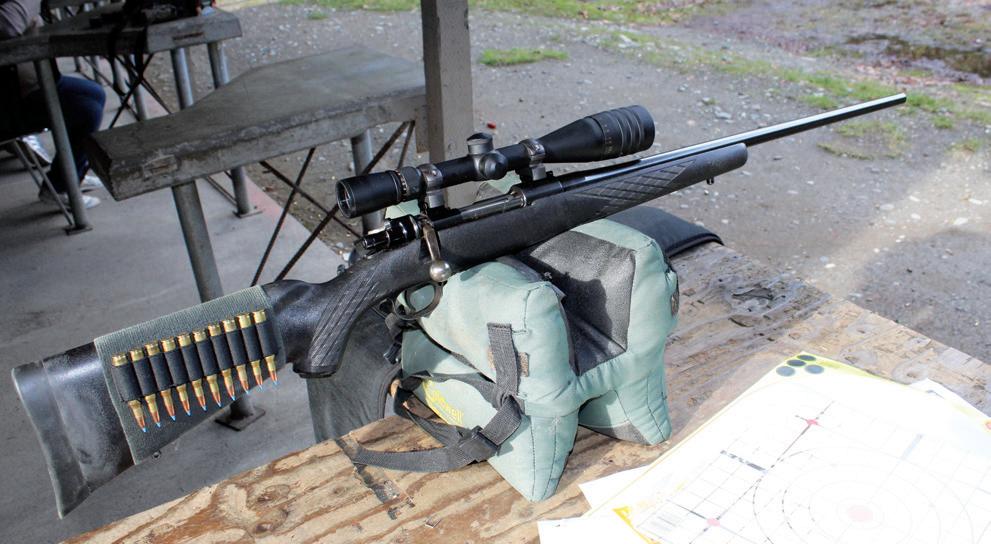
10 minute read
THE CALL OF THE CHILD
HOW TO RAISE A WILD CHILD
A SLIGHTLY TONGUE-IN-CHEEK GUIDE TO PARENTING FOR THE OUTDOORSY FAMILY
BY BJORN DIHLE
Ihave survived avalanches, grizzly charges and my wife’s insatiable rage, but none of these things prepared me for the challenges and dangers of being a dad.
The market is saturated with how-to books on parenting, and all are hogwash, except for Ted Nugent’s books Blood Trails, Blood Trails II and Kill It & Grill It. If you are expecting your first child or already have children and want to be the best parent you can be, I can’t recommend them strongly enough.
Still, for sheer bang for your buck, there is no better text to study than Jack London’s The Call of the Wild. If you haven’t read it, I’ll o er a quick summary: It’s about a spoiled dog named Buck; he’s stolen from a mansion in California and sent to the harsh wilds of the north, where he’s forced to live a life of toil and deprivation. Eventually, after befriending a worn and wise sourdough, Buck surmounts all obstacles, becomes independent and fulfills his primordial destiny of becoming the alpha male of a wolf pack.

Author Bjorn Dihle and his young sons Shiras and Theron are outdoor partners in work and play. Pulling in a personal-use set-net isn’t just a chore, it’s part of their parent-child learning curve. (BJORN DIHLE)

Literary professors say the book is an allegory. Which doesn’t really make sense to me, but if people can be allergic to bread and milk, I guess I can see how reading might give some the runs or hives. Thankfully, there’s also the option of listening to it on tape. It’s well worth your time. The book is basically a parenting manual with the end goal of rewilding your child to their right and natural state as an apex predator. It would be more fitting if it was called The Call of the Child.

WHILE EVERY RED-BLOODED, SANE parent wants their kid to be the alpha member of the wolf pack, rewilding children scares many. For one, there’s the political connotations of how it will a ect the economic and cultural fabric of society. Some are worried it will cause more ESA listings, partisan division, federal overreach and ammunition shortages.
Others are worried for their own safety and point out that it’s bad enough to already have dangerous beasts like pos-

As far as this family is concerned, a bad day picking salmonberries is better than a good day stuck inside
the house. (BJORN DIHLE)
We dare you to find two more eager (or adorable) grouse hunting partners. (BJORN DIHLE) sums and bigfoots infesting our cherished and dwindling wild public lands. Children running amok in nature will only increase attacks on campers and rabies outbreaks. These people are demanding a zero-tolerance policy and a rigid collaring and culling program for children who misbehave to be put in place before they’ll even consider letting children outside.
There is some truth to the danger. My 3-year-old, after watching Disney’s version of The Call of the Wild, has fully invested himself in living by the law of the club and fang. His favorite game is to pretend that I’m Buck and he’s the bad guy with the club who breaks me and then trains me to do his bidding. While I take some comfort in these beatings, knowing that it will prepare the boy for the eat-or-be-eaten reality he’ll enter if preschool ever stops being so uppity and accepts him, it does get tiring always having to look over my shoulder wondering if I’ve done something wrong and when the next blow will come.
Nonetheless, I’m a firm believer in rewilding, even if some naysayers scream that it’s also dangerous for chil-

dren. Sure, some – maybe many in certain circumstances – will die. But those who don’t will be stronger, smarter and faster and, hence, more likely to survive events like an alien invasion or zombie apocalypse – which, let’s face it, is bound to happen sooner or later, according to mathematical odds.

ONE OF THE MOST valuable things we can do as parents is expose our children to the inner wonders and workings of nature. There is nothing more comforting than knowing that if you don’t kill, you will be killed.
Early on, with my older son, I learned he was happiest outside pretty much regardless of the weather. Before he could walk, he was my grouse hunting partner. As soon as he was mobile, his fascination turned to berry picking. The boy knows the leaves of di erent bushes better than me and is always the first to spot berries when we’re walking in the woods.
Then, his fascination turned to fish. At first he’d just stare at salmon spawning in streams, unwilling to leave no matter how much I whined and begged. Next came helping reel in cutthroat trout and Dolly Varden. Then it morphed into constantly asking to go catch and eat a fish. Recently, he and one of his best friends got into a full-on fist fight over whose turn it was to pick sockeye salmon out of a set-net. Both sets of parents were proud.
These days, he’s constantly asking to go hunting, telling me that he’ll pack out the deer and I’ll pack out the moose. I’m stretching and lifting weights to get ready for hunting season, as I’m worried he’ll club the snot out of me if I’m unable to shoulder a moose.
Kids are natural hunters, fishers and gatherers, as long as they are in the right environment. I recommend, as soon as an infant can squirm around, setting them outside somewhere with a good population of worms and letting them go to work. Adopt the teachings of wolves, and when you bring home a kill of your own, allow your child to get hands-on.
It can be as simple as tossing grouse and fish heads to your baby instead of a ball. If you bring home a whole deer or other large mammal, babies love nothing more than playing inside body cavities. Perhaps it’s due to being fresh out of the womb. One of the main reasons I like hunting moose is because, hollowed out, they o er enough room for all the children in my neighborhood to play inside.
Your baby is going to need as many blood brothers and sisters as possible to increase the odds that they will one day be able to pass on your genetic legacy. Want a pro parenting tip and a way to cut down on costs? Forget plastic toys; kids love playing with bones more than just about anything else. Eyeballs, kidneys and brains are great substitutes for stu ed animals and Play-Doh, but be warned that after a week or so, they lose some of their luster.

IT’S EASY TO BE ddisturbed, outraged and even o ended by other parents’ unnatural, coddling approach to their children.
Theron Dihle admires a tub full of sockeye. “Kids are natural hunters, fishers and gatherers as long as they are in the right environment,” his dad writes. “I recommend, as soon as an infant can squirm around, setting them outside somewhere with a good population of worms and letting them go to work.” (BJORN DIHLE)
Most people, however, respond well to being told that they’re bad parents and they should raise their children the way you tell them to. Even better, do something generous like o ering to help wean their baby from the boob by dropping them o with brown bears or wolves. Not only will this promote a healthy, organic way for a baby to take the first step toward independence, but it will also o er a platform where they can learn invaluable life lessons while being challenged to achieve their full potential of becoming a rewilded apex predator.
If that seems too much, you can suggest taking the kid to do something like hunting, fishing, gathering or gardening. After all, there are few things more haunting than the call of the child. On a surface level the screaming and crying might appear because a child stole another’s toy, or they didn’t get their way, or they need their diaper changed. But on a deeper level, plain and simple, it’s a call to return to their right and natural state and run with the wolves. ASJ
Editor’s note: Bjorn Dihle is a Southeast Alaska writer. His most recent book is A Shape in the Dark: Living and Dying with Brown Bears. Order it at amazon. com/Shape-Dark-Living-Dying-Brown/ dp/1680513095.
Shiras and his Farfar (grandpa) teamed up for a nice Dolly Varden. Shiras’ parents find the outdoors far more educational than any toy store. “Want a pro parenting tip and a way to cut down on costs?” the author writes. “Forget plastic toys; kids love playing with bones more than just about anything

else.” (BJORN DIHLE)








Cumberland’s

Northwest Trappers Supply, Inc.
Cumberland’s Northwest Trappers Supply is your one-stop trapping supply headquarters, featuring one of the largest inventories in the U.S. We are factory direct distributors on all brands of traps and equipment which allows us to offer competitive prices. Give us a try. Our fast, friendly service will keep you coming back.
Over 50 Years Of Service To The Trap & Fur Industry



Request A Catalog Or Place An Order By Phone, Mail Or On Our Website If you get in the area, visit our store!
We are the new home of “Trappers Hide Tanning Formula” in the bright orange bottle. Retail & dealer inquiries are welcome.
P.O. Box 408, Owatonna, Minnesota 55060 • (507) 451-7607 trapper@nwtrappers.com • www.nwtrappers.com
CUMBERLAND’S NORTHWEST TRAPPERS SUPPLY
Hide Tan Formula has been used successfully by thousands of hunters and trappers across the U.S. and Canada. No more waiting several months for tanning. Now, you can tan your own hides and furs at home in less than a week, at a fraction of the normal cost. Our Hide Formula tans deer hides either hair-on for a rug or mount, or hair-o for buckskin leather. Tans all fur skins – muskrat, mink, beaver, fox, coyote, raccoon, squirrel, rabbit, etc. It also applies to bear, elk, moose, cowhide, sheep and even snakeskin. Hide Tan Formula is premixed and ready to use and produces a soft, supple Indian-style tan in five to seven days.
One 8-ounce bottle will tan one deer hide in two medium-sized fur skins. Bear, elk, moose and caribou require three to six bottles. Complete instructions are included. You’ll be amazed how easy it is!
Tanned hides and furs are great to decorate your home or camp and also to sell for extra income. Tanned hides and furs are in demand by black powder enthusiasts, American Indian traders, fly tyers, country trading posts and many crafters. Our products are proudly produced and bottled in the U.S. for over 20 years.
Available at Cumberland’s Northwest Trappers Supply in Owatonna, Minnesota.
Call (507) 451-7607 or email trapper@nwtrappers.com. nwtrappers.com







